One would think that the most savage and life-threatening creatures are normally found in exotic foreign lands. However, England isn’t entirely void of potentially dangerous animals. Britain has its fair share of dangerous spiders, scorpions, and snakes. British wildlife is generally safe. But some of the most dangerous insects in England include bugs that you wouldn’t even think of. Luckily, people in England no longer need to worry about large carnivores such as wolves and bears because they were wiped out centuries ago. Also, they do not need to worry about an abundance of deadly snakes and spiders like people in Australia. There are, however, a few insects that are best avoided.
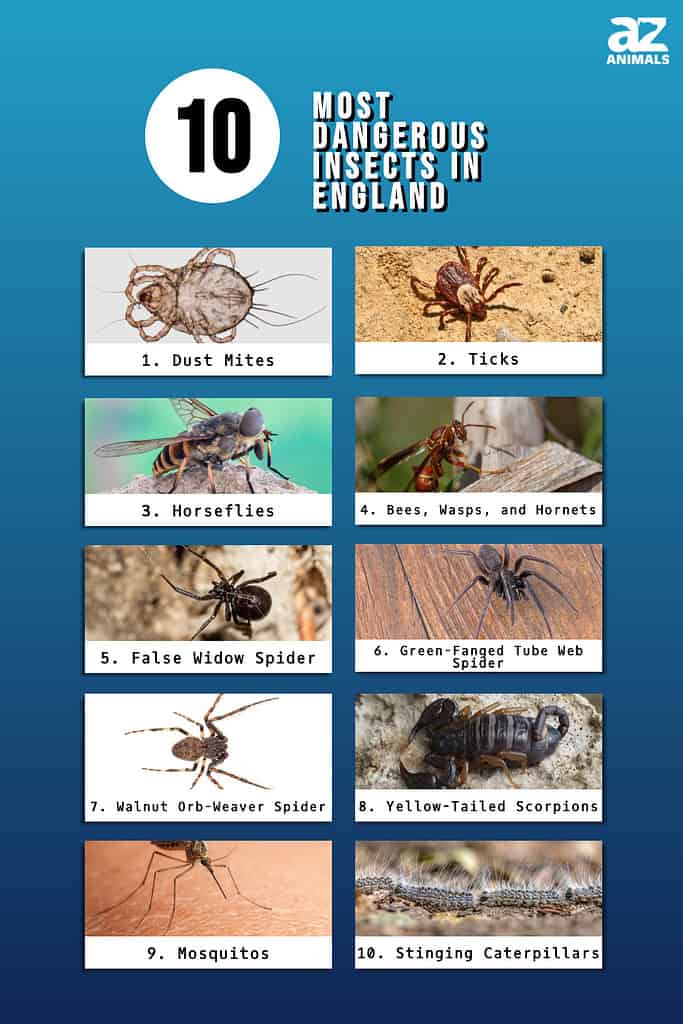
1. Dust Mites
Dust mites can be considered one of the most dangerous insects in England. These creepy critters are too small to see with the human eye. They feed on dead skin cells and flourish in humid, warm environments. Dust mites do not bite or sting like other insects. Rather when humans inhale the proteins that come from their urine, decaying bodies, or feces, they develop allergies. Also, swelling of the nasal passages caused by dust mites is called a dust allergy. The most common place to find dust mites is on your mattress and bedding, but they also live in upholstered furniture, curtains, or carpets. They occur in most households, and many dust mite allergies occur when you are sleeping. Lastly, they favor humid conditions because they do not drink water but absorb moisture from the air.
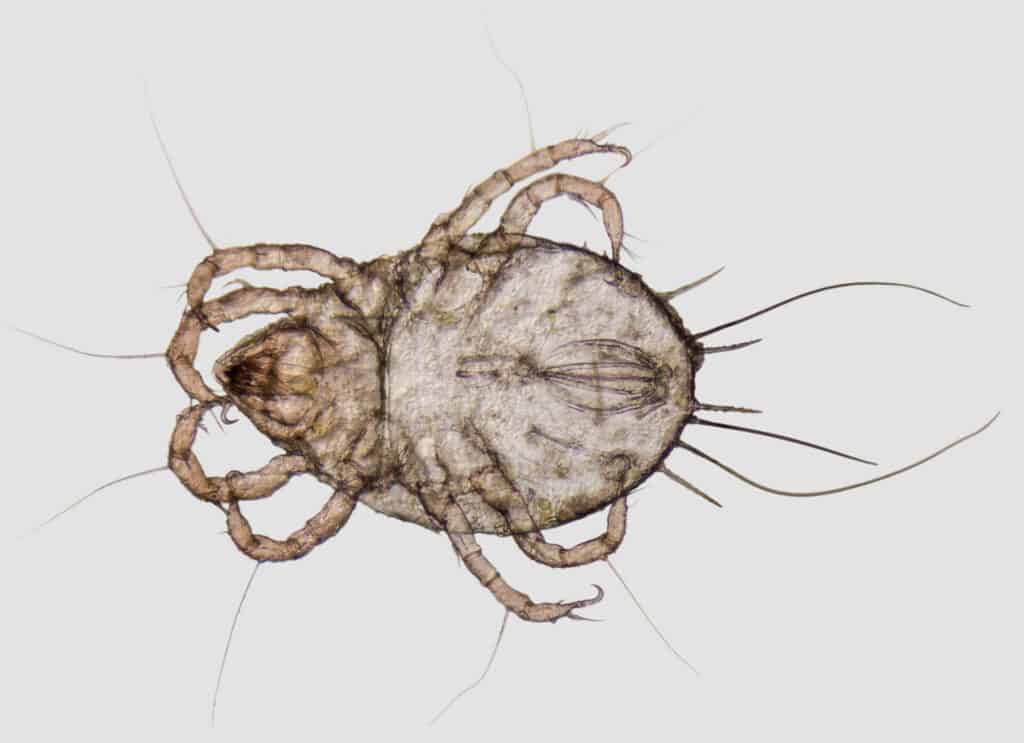
Dust mites feed on dead skin cells and flourish in humid, warm environments.
©iStock.com/prill
2. Ticks
There are many types of ticks worldwide, some brown or reddish-brown and some darker. Also, some are small, and others are larger. These insects are classified as arthropods because they have eight legs, like spiders and mites. Ticks can infect humans and animals with bacteria and viruses. Additionally, they are small and sometimes not seen until they feed on enough blood and become larger. They feed on warm-blooded hosts, and several conditions that they spread may be serious and include:
- Tularemia
- Ehrlichiosis
- Lyme disease
- Babesiosis
- Anaplasmosis
- Powassan virus
- Heartland virus
- Relapsing fever
- Spotted fever
- Colorado tick fever.

There are many types of ticks worldwide, some brown or reddish-brown and some darker.
©Jerry Kirkhart from Los Osos, Calif., CC BY 2.0 <https://creativecommons.org/licenses/by/2.0>, via Wikimedia Commons – Original / License
3. Horseflies
Horseflies are one of the most dangerous insects in England. Belonging to the Tabanidae family, horseflies depend on blood for making eggs and nutrition. This is because animal blood has a certain protein needed to help develop their eggs. Horseflies feed on large dark-colored animals such as horses and cattle. However, that does not stop them from biting a human when they encounter one. These insects favor wet areas such as coastal regions. In addition, they are bigger than normal house flies and have large eyes and blade-like mouths.
Male horseflies feed on flower nectar, while females feed on flower nectar and blood during mating season. As a result, horseflies become dangerous, as the females must drink blood to reproduce. Horseflies mate in summer, which is the perfect time to feed on humans as they are outside enjoying the warmer weather. There are certain places that horseflies primarily occur, including:
- Marshes
- Creeks
- Waterfalls
- Beach dunes
- Termite mounds
- Pond shores.
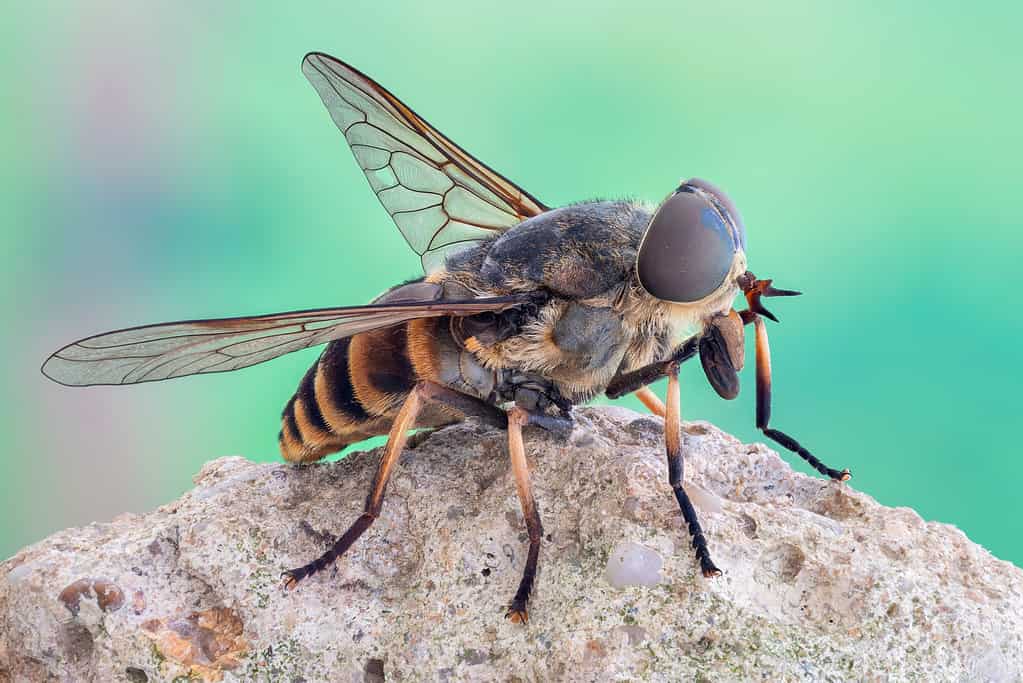
Male horseflies feed on flower nectar, while females feed on flower nectar and blood during mating season.
©iStock.com/guraydere
4. Bees, Wasps, and Hornets
Many species of bees, wasps, and hornets can be found around the world. In the United Kingdom, only a few of these species occur. For example, some insects, such as honeybees, are integral to the ecosystem. German and common wasps also occur in England, and they are responsible for very painful stings. Additionally, they like to build their nests in sheltered places such as garages, lofts, and wall cavities. They can also be found outside in bushes and hollow trees. European hornets also occur in the United Kingdom. These insects have an orange abdomen with brown stripes and a very painful sting.
As previously mentioned, honeybees occur in England. These bees are the ones kept by beekeepers to produce honey. They occur in roof spaces, hollow trees, or chimneys. In addition, they are mostly black and convert nectar into beeswax and honey. Furthermore, they have a painful sting, and a colony can consist of more than 30,000 bees. You will also find the solitary bee in England. These bees, as the name suggests, live alone. They look similar to honeybees but feed only on honey and pollen.
On the other hand, they are not aggressive. Finally, you get the Mason bee. The mason bee is not aggressive and occurs mostly in Southern Britain. They include the mining bee, the hairy-footed flower bee, the red mason bee, the leafcutter bee, and the wool-carder bee.

German and common wasps occur in England, and they are responsible for very painful stings.
©pixelworlds/Shutterstock.com
5. False Widow Spider
False widow spiders are one of England’s most dangerous insects because they are the most poisonous spider that inhabits Britain. A bite from this spider will cause swelling, pain, burning, numbness, nausea, and chest pain. Luckily, they are not to be confused with the deadly black widow spider. Their bite will be painful, but the symptoms are not fatal and should only last about 12 hours. The name false widow is given to species in the genus Steatoda. There are six of these that occur in the United Kingdom. The three most common ones are the cupboard spider, noble false widow, and rabbit hutch spider.
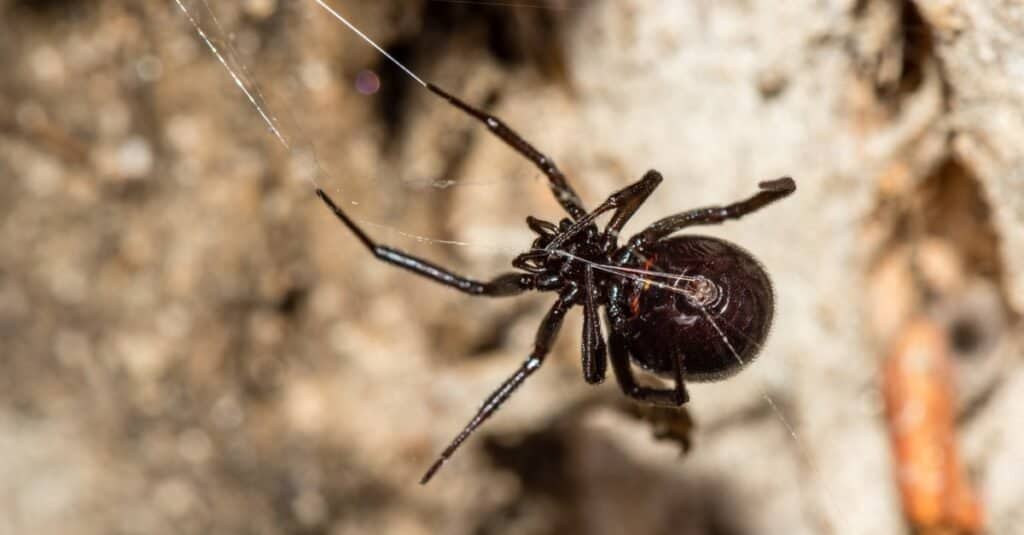
The most poisonous spider that occurs in Britain is the false widow spider.
©Danie Spreeth Photography/Shutterstock.com
6. Green-Fanged Tube Web Spider
As with the false widow spider, the green-fanged tube web spider is one of England’s most common biting spiders. These spiders are quick to attack, and their bite is painful but not deadly. Symptoms should only last around five to six hours, with mild discomfort. They are large black spiders with green fangs. Also, they are one of the biggest spiders that inhabit Britain.
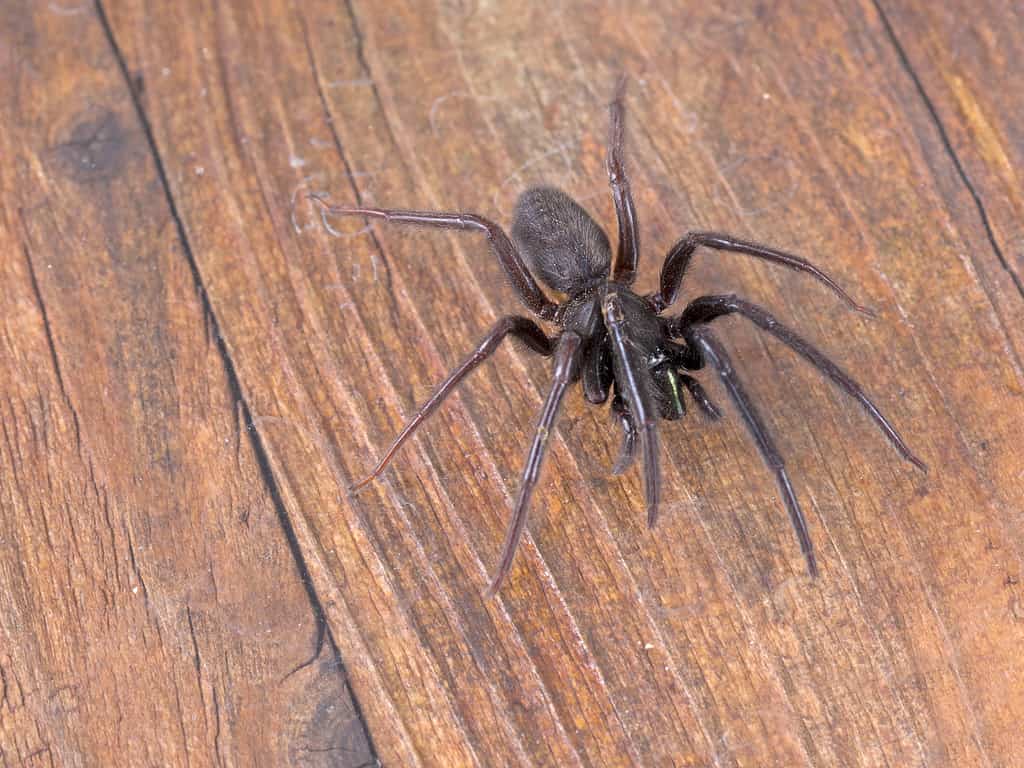
The green-fanged tube web spider is quick to attack, and its bite is painful but not deadly.
©iStock.com/Goldfinch4ever
7. Walnut Orb-Weaver Spider
Just behind the false widow, the walnut orb-weaver spider is the second-most venomous spider in the United Kingdom. However, they are not deadly, but their bite is very unpleasant. If you are bitten by one of these spiders, you will experience numbness, burning, and swelling. Additionally, they are relatively small and difficult to spot sometimes. They have a round abdomen with black and brown markings. Lastly, they are nocturnal and mostly come out at night.

The walnut orb-weaver spider is the second-most venomous spider in the United Kingdom.
©iStock.com/Danut Vieru
8. Yellow-Tailed Scorpions
These scorpions can be found close to coastal towns in southern England. However, the largest population of yellow-tailed scorpions occurs at Sheerness Docks on the south-facing, crumbling walls. Also, these scorpions have occurred in England for more than 200 years. Their bite can be very painful and not comfortable at all.

The largest population of yellow-tailed scorpions occurs at Sheerness Docks on the south-facing, crumbling walls.
©iStock.com/Wirestock
9. Mosquitos
Mosquitos are found all over the world. There are more than 3,500 types of mosquitos. Their bites can cause swelling and itchiness. However, they are vectors. They spread disease when they bite humans or animals. Furthermore, they spread diseases such as malaria, dengue fever, Zika virus, yellow fever, and the West Nile virus.

There are more than 3,500 types of mosquitos.
©Anest/Shutterstock.com
10. Stinging Caterpillars
In England, you may find stinging caterpillars. These creatures may look cute, but their hairs carry a poison that may hurt or even kill people. These caterpillars start as Oak processionary moths (OPM), laying their eggs in oak trees. Interestingly, they have over 62,000 long white hairs, carrying a poison that makes animals and humans itch. Additionally, their poison can affect your eyes and skin and make it hard to breathe.
These caterpillars mostly live in southern Europe, where they have many natural predators that keep the population in check. It is believed that they reached the UK on oak trees that were taken over from Europe. Unlike in Europe, England does not have many natural predators. Therefore, the population is not kept under control. Workers in England have found 600 places in London where these caterpillars have made nests. However, they do spray them to try to get rid of them.
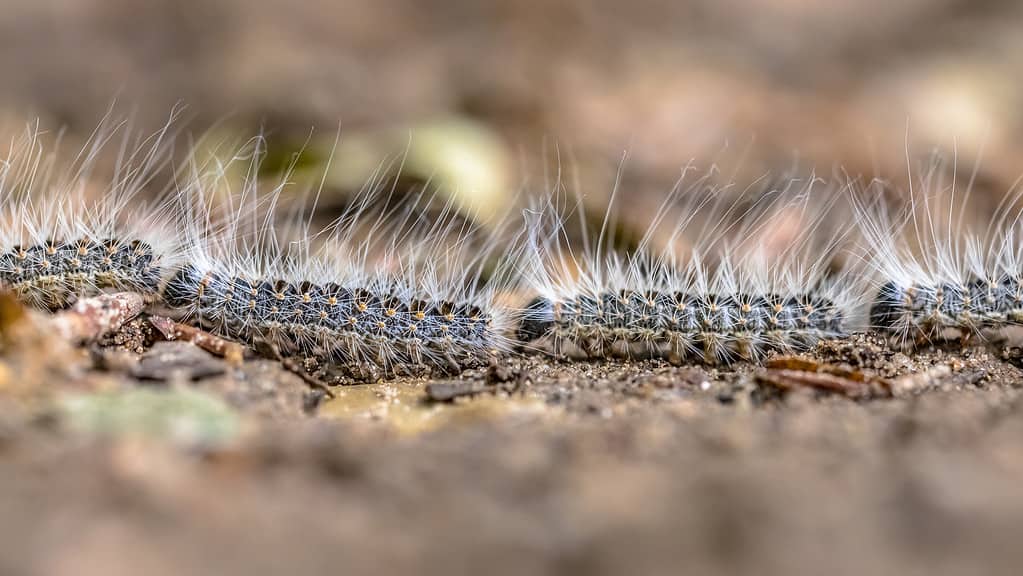
Stinging caterpillars have over 62,000 long white hairs, carrying a poison that makes animals and humans itch.
©iStock.com/CreativeNature_nl
Summary of 10 Most Dangerous Insects in England
Here’s a recap of the top 10 deadliest insects we looked at that are found in England.
| Number | Insect | Danger Posed |
|---|---|---|
| 1 | Dust Mites | Proteins from urine, decaying bodies, or feces cause allergies in humans when inhaled. |
| 2 | Ticks | Can infect humans and animals with bacteria and viruses |
| 3 | Horseflies | Females must drink blood to reproduce so humans can be bitten when outside in summer. |
| 4 | Bees, Wasps, and Hornets | Responsible for very painful stings |
| 5 | False Widow Spider | Bites cause swelling, pain, burning, numbness, nausea, and chest pain. |
| 6 | Green-Fanged Tube Web Spider | Bites are painful but not deadly. |
| 7 | Walnut Orb-Weaver Spider | Bites are very unpleasant and cause numbness, burning, and swelling. |
| 8 | Yellow-Tailed Scorpions | Bites can be very painful |
| 9 | Mosquitos | Spread diseases such as malaria, dengue fever, Zika virus, yellow fever, and the West Nile virus |
| 10 | Stinging Caterpillars | Hairs carry a poison that may hurt or even kill people. |
Thank you for reading! Have some feedback for us? Contact the AZ Animals editorial team.








